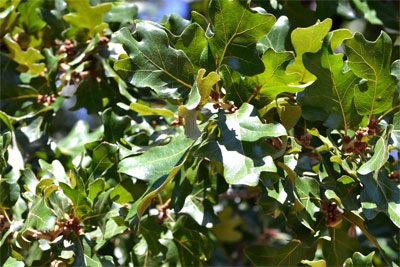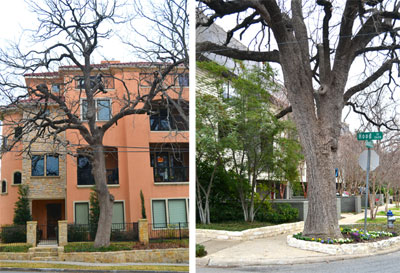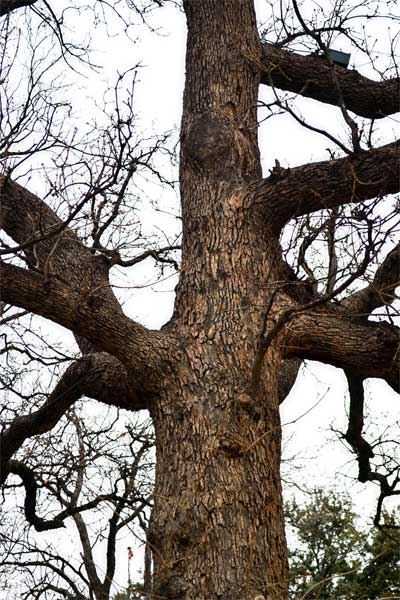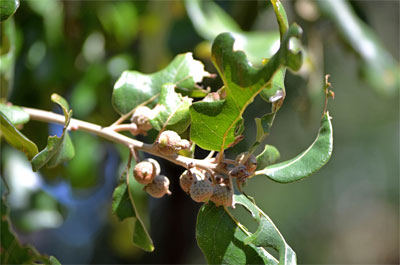Texas Tree Tips – January, 2013

Post oak trees are heat and drought tolerant. While other trees may show signs of stress, post oak foliage remains glossy and green. Photos courtesy of Steve Houser.
Tree Species Profiles — Top-Rated Shade Trees
Post Oak, Quercus stellata
As a tree species, post oak, Quercus stellata, is a true Texas native and one tough hombre. Richard Francaviglia noted in his book The Cast Iron Forest that “In his travels to the western frontier in the early 1830s, American writer Washington Irving characterized the Cross Timbers as ‘forests of cast iron.’” The comment referred to post oaks and the other native trees and plants in forests that were almost impenetrable. The North American Cross Timbers is an ecosystem that runs south from Kansas through Oklahoma, with two primary bands stretching into northern Texas. The underlying soil is sand, often with a great deal of iron-rich rock. Although post oaks prefer this soil mix, they often grow outside the Cross Timbers area and into East Texas and other states to the north and east. They survive in dry, rocky, upland sites, but also can be found in deeper and richer soils.

While having a reputation for being highly sensitive to construction, native post oaks can withstand development and re-development.
Post oaks are able to grow in tough, rocky conditions and can survive scorching summers, bitter cold fronts, and drought, as well as almost anything else nature can whip up — a truly tough Texan that would make even John Wayne proud. They can live to be more than 400 years old and obtain heights of up to 80 feet, with crown spreads of 60 feet or greater. According to some plant taxonomists, one or more smaller varieties may exist that are much shorter with smaller leaves. One of note is called sand post oak, Quercus stellata var. margaretta.
Post oak leaves are lobed and become progressively narrower near the base. Some call the species “Cross Oak,” which may be due to the cross shape of the veins in the leaves (which turn slightly upward), or because the tree is part of the Cross Timbers ecosystem. Post oaks are quite likely to be found with their favorite sidekicks, the blackjack oaks, Quercus marilandica. Although the two are the best of buds, post oak is in the White Oak family and blackjack oak is in the Red Oak family. One other difference is that blackjack oak’s leaves have small points on the ends of each leaf lobe.

Post oaks’ strong branching habit makes them resistant to damage from wind and ice. This branching characteristic makes them easy to identify during winter months.
Fall color is not great, but the wood strength and branching habit are very strong. Branching habit refers to the typical angle of attachment of limbs. In general, the greater the attachment angle is, the stronger the wood is.
Post oak seedlings are available and can be purchased through Internet nursery sites. Since they are very drought tolerant, and water for irrigation may be limited in the future, post oak trees should be planted more often. They can be slow-growing in the wild or in tough soil conditions, but they grow at a moderate rate with proper care. They are not very tolerant of wet or compacted soil, but have proven to adapt and survive in urban environments.

Post oak acorns provide a valuable food source for wildlife. In mast years, acorns can cover the ground.
Post oak acorns are a true favorite of wild turkey, quail, deer, raccoons, and other wildlife. The acorns also feed small insects, which feed the fish, which helps the fishermen. The acorns please the naturalist because they feed the rats and mice that help to benefit the rest of the food chain (raptors, snakes, and small mammals). And you thought it was just an acorn.
While the research is limited and the subject complex, there is promise that drought-tolerant trees and plants like post oaks may be the best selections for improving air quality.
To learn more about post oaks and the Cross Timbers, read The Cast Iron Forest — A Natural and Cultural History of the North American Cross Timbers, by Richard V. Francaviglia, University of Texas Press, Austin.
About the author: Steve Houser is a Dallas native with more than 30 years of experience as a consulting arborist and tree climber. He is the president of Arborilogical Services Inc., “The Experts Your Trees Deserve.” www.arborilogical.com.

